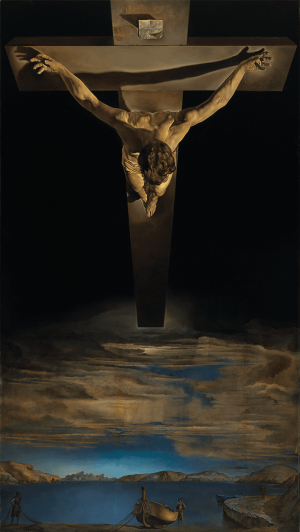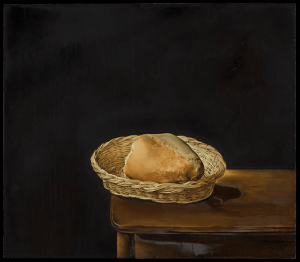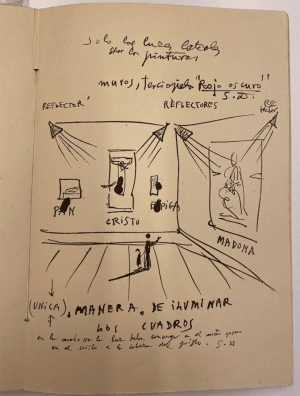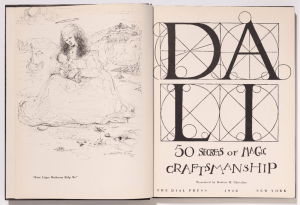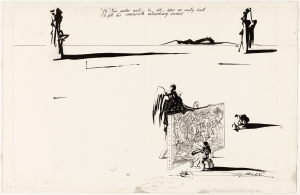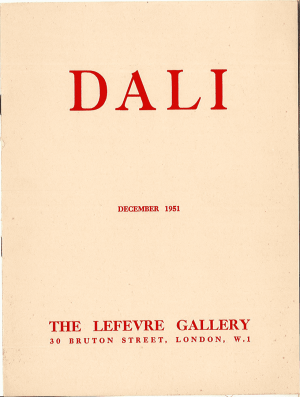The Exhibition
THE CHRIST OF PORTLLIGAT
The exhibition Dalí. The Christ of Portlligat, centred on the oil on canvas The Christ by Salvador Dalí, an exceptional work from the Kelvingrove Art Gallery and Museum in Glasgow, enables the Fundació Gala-Salvador Dalí to go beyond its own collection and in so doing to expand and enrich our understanding of the artist.
The painting, exhibited in a special space that is both scenographic and an invitation to contemplation, had not been seen in Spain since 1952, when it was shown in Madrid and Barcelona[1]. Above all, it allows us to delve deeper into the artist’s creative process and also into the importance of the studio and the landscape in which it is set, which inspired and shaped it, by way of new contributions from the knowledge acquired over the course of time and from archival materials, some of them previously unpublished.
At the same time, and only for the second time since the inauguration of the Dalí Theatre-Museum in Figueres in 1974, another painting, of pivotal importance for the artist, The Basket of Bread (1945)[2], leaves its place of honour in the Treasure Room to further extend and complement the significance of The Christ. When Dalí painted The Basket of Bread he clearly had the idea of The Christ already in mind. If not exactly the idea of this painting, perhaps, then that of a Christ that connects with the sacrament of the Eucharist and represents a classicism pervaded by a certain transgression or innovation, at least in formal terms. These two works have the same technical mastery, formal composition and photographic realism, and the chiaroscuro that gives an almost sculptural relief to the figure. They also share the same light, a deliberately scenographic light, which brings drama to the figure and increases its mystical perception.
Dalí painted The Christ[3] in 1951 in his studio in Portlligat as the conclusion of a moment of transformation and also the culmination of his desire to become a classic and the “saviour” of modern painting[4]. The incorporation of religious representations and episodes into his artistic corpus is, together with the embrace of the postulates of quantum mechanics, a reflection of the evolution of the artist’s thinking. While The Christ is not the work that fully exemplifies this change, it is the painting that links the two stages, the work that embodies a transition and leads us towards the nuclear mystical period.
In representing the passion of Christ from a surprising perspective, Dalí had his eyes fixed on the Spanish mystics, especially John of the Cross, and with a very elaborate geometry: the Christ is suspended above the bay of Portlligat, Dalí’s vital landscape, in a crepuscular tone and with blues that the photographer Gyenes said he “had not seen anywhere else”[5].
This enigmatic work challenges us and an invitation to contemplation, a leisurely contemplation, to be savoured. Hanging in a room draped with dark red curtains, it exercises all the power of attraction of the most iconic artworks. As Tom Honeyman declared, the aim is that this exhibition and this painting should have a surprising effect of on the emotions of the great majority of viewers.
Montse Aguer
50 Secrets of Magic Craftsmanship. The Craft of Painting.
Dalí was emulating the classical treatises on painting, and especially those by Cennino Cennini and Leonardo da Vinci, when in 1948 he published in the United States 50 Secrets of Magic Craftsmanship, a handbook which, according to the artist, is “a technical and at the same time a philosophical book. In it I analyse and summarise all my ideas, theories, principles and comments on pictorial art”[6].
Despite his contradictions, in 50 Secrets of Magic Craftsmanship Dalí supplies us with insights into how essential painting was to him. Painting understood as a craft. At the same time he champions aspects such as learning from those he considers the great masters of the history of art-Vermeer of Delft, Velázquez, Raphael, Leonardo, Michelangelo and also Picasso-while looking towards the latest technical innovations. In Dalí, there is always a balance between tradition and revolution. As he reminds us in the essay ‘”The Decadence of Modern Art”, written two years after 50 Secrets of Magic Craftsmanship: “Painter! Continue the constructive side of your modern masters in order to integrate it into the tradition of your ancients. So classic art will become again living and modern![7]
Dalí describes his working method and details how it should be applied, and also advises and sets out rules on how the artist’s life and his or her studio should be. In addition, he speaks to us about materials, colours, textures, techniques, geometries and volumes. This handbook brings us closer to a Dalí immersed in his work, obsessed with achieving a perfection he knows he will never achieve. It also helps us enter into the creative process and the working method he used in his paintings, from the conception to the studio, the sketches, the preparatory drawings and the application of the final layer of pigment on the canvas. In the case of The Christ, in addition to numerous sketches, he sought out models, often taken from photographs, which he then transferred to the canvas, the final composition. Always abiding by his own formulas in his 50 Secrets of Magic Craftsmanship, Dalí judged himself a good painter in comparison with his contemporaries, albeit a mediocre one in the great canon of art history.
Dalí was obsessive in his pursuit of technical perfection: he sought mastery. He wanted to create a masterpiece. In the dedication to 50 Secrets of Magic Craftsmanship he wrote: “Now at forty-five I want to paint a masterpiece and to save Modern Art from chaos and laziness. I will succeed! This book is consecrated to this crusade and I dedicate it to all the young, who have faith in true painting”[8]. The Christ may well be the masterpiece he so wanted to paint. It is a work of great technical perfection, surrounded by an aura of enigma, with an unexpected composition, a reconfigured iconography and a universal theme that the artist made his own by transferring it to his Portlligat universe. A work that makes a stand against the “void of modern art&rdquo[9]; and constitutes an apologia for oil painting. As he advised young painters: “Instead of trying to reinvent painting, paint!”[10]. And in one of the letters he wrote to Tom Honeyman, director of the Kelvingrove Art Gallery and Museum in Glasgow and artificer of the purchase of The Christ, he explicitly declared “Ge trabaille, trabaille, trabaille! [sic]”[11], principles that guide him in his constant, and impossible - we would say - search for perfection.
Montse Aguer
HISTORY AND PROVENANCE OF THE CHRIST
The story of how The Christ arrived at the municipal art gallery in Glasgow has one outstanding protagonist. Tom Honeyman (1891-1971) was someone with extensive experience in the world of art, who had known and greatly appreciated Dalí’s work since 1936 and who visited the artist’s exhibition at the Lefevre gallery in London[12], in December 1951, just a few months after he completed the picture in his Portlligat studio. It is hardly surprising, then, that when he visited that exhibition he should have felt that the acquisition of The Christ would make a great addition to the already important collection of the museum of which he had been the director since 1939. Moreover, the painting made a great impression on him: “Still puzzled I returned to the painting and the crowd. My chief difficulty was how to reconcile the theme with Dalí’s philosophy of art and public utterances as I remembered them. [...] The painting seemed out of period: a piece of unashamed romanticism in an age of eclectic classicism”[13].
However, the purchase was neither easy nor free from controversy. After extended negotiations by letter with Salvador Dalí, the painting and the reproduction rights to it were sold to the city of Glasgow for a sum that was certainly high for the time. The price was the specific cause of a heated polemic, especially in academic and artistic circles of Scotland, with influential figures arguing that that money instead be used to create exhibition spaces for local artists. Nevertheless, The Christ by Salvador Dalí was exhibited for the first time in Glasgow in June 1952 and became an authentic “art event” in the city. As Honeyman was pleased to inform Dalí, Glasgow “had a glorious summer with your picture”[14].
A little later, in 1954, the work was shown in Rome[15], and was not loaned again for almost a decade, not without sparking fresh controversies. A few years later, on April 23, 1961, a visitor to the Glasgow museum tried to destroy the painting, slashing the canvas and pelting it with stones, which led to the work being taken down and carefully restored. In 1993, The Christ moved temporarily to Glasgow’s St Mungo Museum of Religious Life and Art until 2006, and the reopening of the Kelvingrove Art Gallery and Museum after a major renovation, when it returned to its habitual location. The fact is that although the painting was again loaned to various exhibitions in Europe and beyond after the attack, it has been seen outside Glasgow very few times since 1965.
Now, and for the first time since 1952[16], The Christ returns to the land of its birth and is being shown in the museum of its creator, the Dalí Theatre-Museum, together with one of the most precious works in its collection, The Basket of Bread, with which it certainly has a close symbolic relationship.
Claudia Galli and Lucia Moni
-
The first Bienal Hispanoamericana de Arte was held in Madrid from 12/10/1951 to 28/2/1952, and in Barcelona in March 1952.
-
Catalogue Raisonné of Paintings by Salvador Dalí, num. P607.
-
Catalogue Raisonné of Paintings by Salvador Dalí, num. P667.
-
The given name Salvador means “saviour”.
-
Translated from Barreira, “Dalí, pintor de un siglo”, Triunfo, 10/10/1951, Madrid.
-
Translated from Armando Rivera, “Hablando con Salvador Dalí”, Ecos, 28/12/1947, New York, p. 30.
-
Salvador Dalí, “The Decadence of Modern Art”, Herald American, 20/08/1950, Syracuse, p. 16.
-
Salvador Dalí, 50 Secrets of Magic Craftsmanship, Dial Press, New York, 1948, p. 5.
-
Ibid, p. 9.
-
Salvador Dalí, “Dalí’s Conference”, Dalí News, 20/11/1945, New York, p. 3.
-
Letter from Salvador Dalí to Tom Honeyman, 26/07/1952, National Library of Scotland, Edinburgh.
-
Dalí, The Lefevre Gallery, London, from 01/12/1951 to 31/12/1951. Detailed information about this work can be consulted on the website of the Catalogue Raisonné of Paintings by Salvador Dalí: https: /en/artwork/catalogue-raisonne-paintings/obra/667/the-christ.
-
T. J. Honeyman, “Recent History II”, Scottish Art Review, Vol. IV, num. 2, 1952, Glasgow, p. 4.
-
From the letter from Tom Honeyman to Salvador Dalí, 07/10/1952, Fundació Gala-Salvador Dalí, Figueres.
-
Mostra di quadri disegni ed oreficerie di Salvador Dalí, Sale dell’Aurora Pallavicini, Rome, from 13/05/1954 al 30/06/1954.
-
The only occasion on which it was shown in Spain was at the first Bienal Hispanoamericana de Arte, which was held in Madrid from 12/10/1951 to 28/2/1952, and in Barcelona in March 1952.


